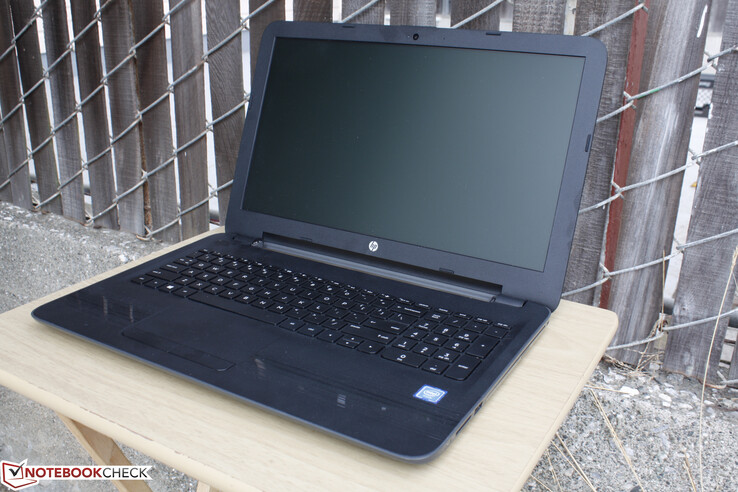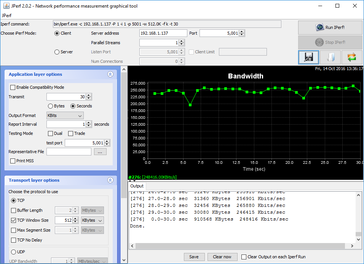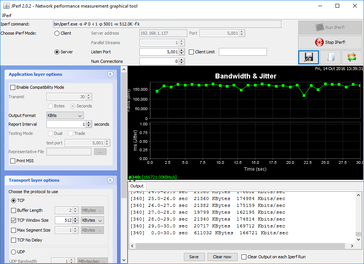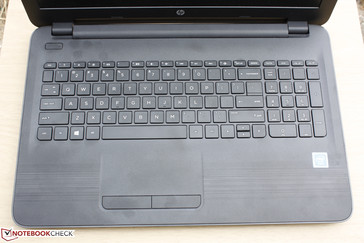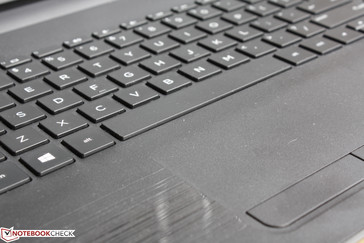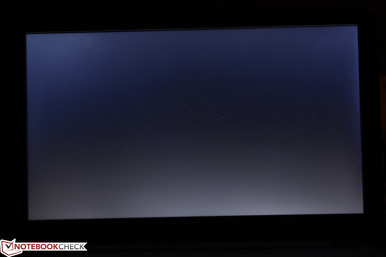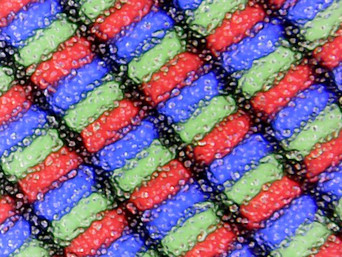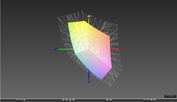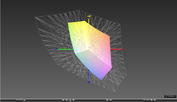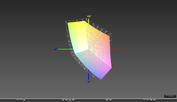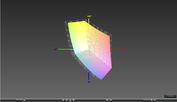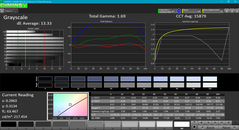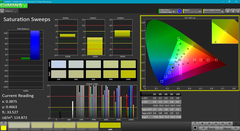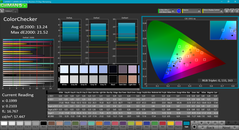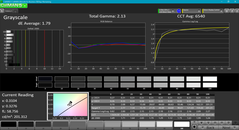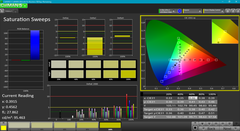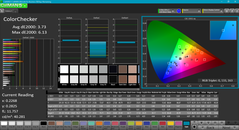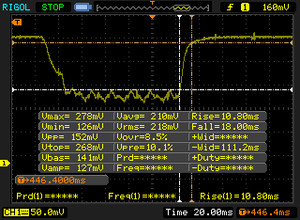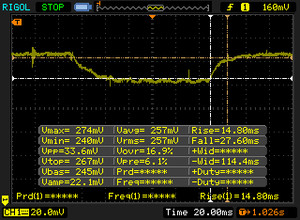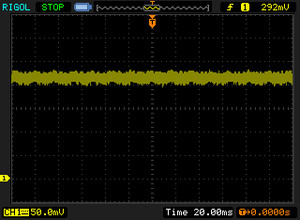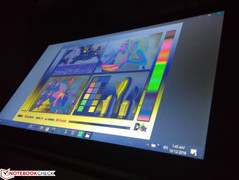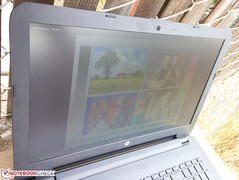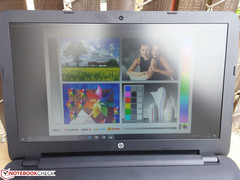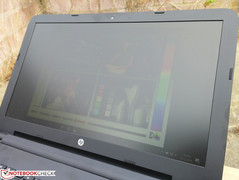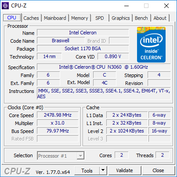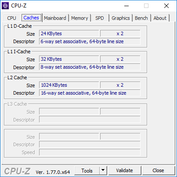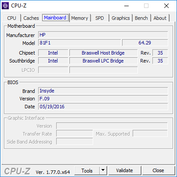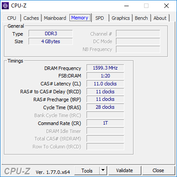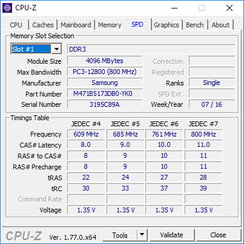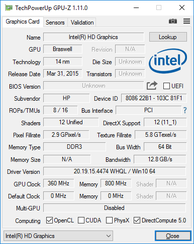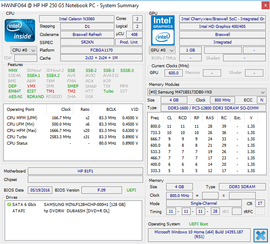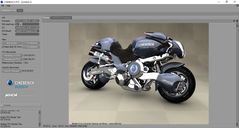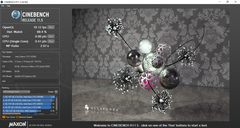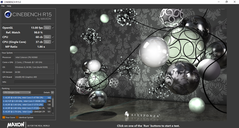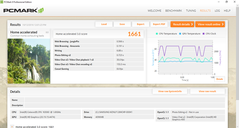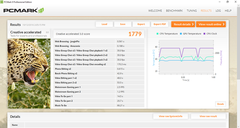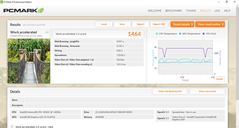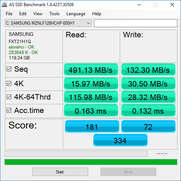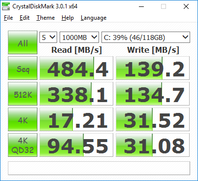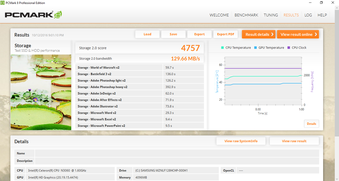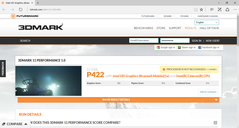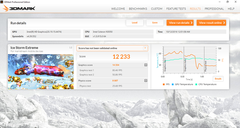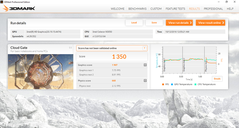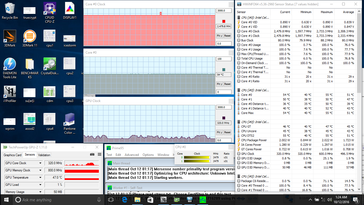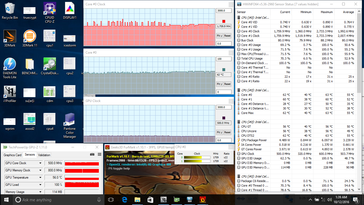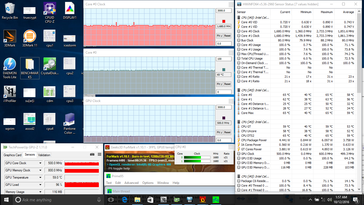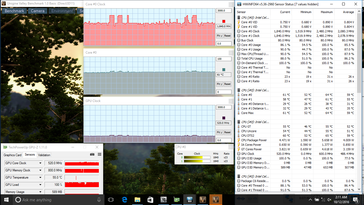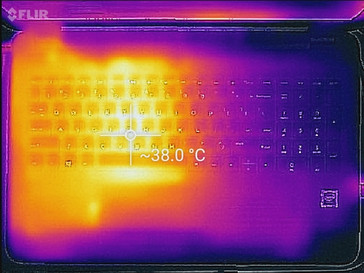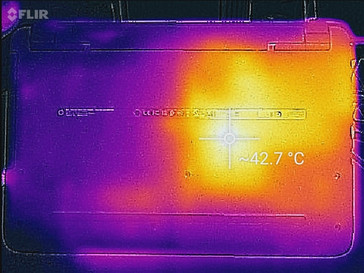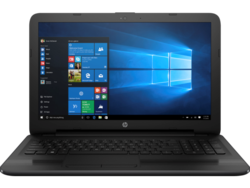HP 250 G5 Y1V08UT (Celeron N3060, HD) Notebook Review
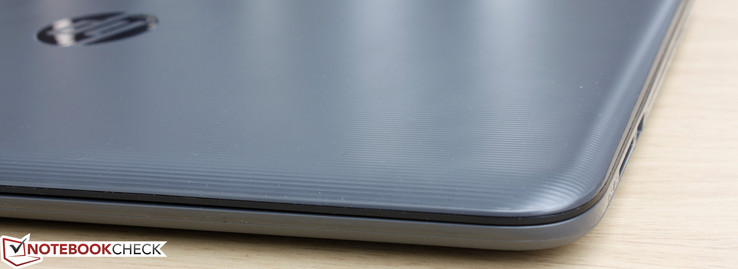
Take one step back from the EliteBook, Envy, Spectre, and Pavilion series and you're left with some of HP's more affordable notebooks. The HP 250 G5 is the Skylake/Braswell update to the Broadwell 250 G4 launched just earlier this year.
Differences between the G4 and G5 are largely skin deep outside of the processor update. Our unit today carries the lowest-end configurable CPU available: The Celeron N3060 with integrated HD Graphics 400 and a 768p display. We also have the i5-6200U SKU with the 1080p panel under review and both of these review pages should give a better idea of what the 250 G5 series has to offer.
Other 250 G5 SKUs include the Pentium N3710, Core i3-5005U, and i7-6500U with SSD and HDD options. Since the 250 G5 is so similar to the 250 G4, however, we recommend checking out our existing 250 G4 page as they share the same hardware features and a nearly identical chassis. Can this $300 250 G5 configuration pass as a full-fledged Windows 10 notebook? Or are the $500+ SKUs with faster Core ix options worth the investment?
Case
Visually, the HP 250 G5 does little to hide the fact that its chassis is entirely matte plastic. Textures are slightly different than the 250 G4 including the new ridges running across the outer lid (similar to the HP 15z) and the glossy accents on the palm rests. Otherwise, the G5 is identical to the G4 with that same plastic "budget" feel.
Case quality is average around the base with some minor creaking when applying pressure on the keyboard and palm rests. The hinges are rigid up to their ~130-degree maximum angle with no teetering and we can observe no unintended gaps between materials. The lid is weaker and more susceptible to twisting as anticipated, but the outer lid in particular feels weak. Pushing down on the center of the outer lid with even minimal force will result in visible flexing. Additionally, the optical drive is very flimsy when ejected for loading and unloading. For the price, however, there are no major complaints in terms of workmanship.
Size and weight when compared to competing affordable 15.6-inch notebooks are very similar. Most notebooks in this price range don't deviate far from a weight of 2 kg or a thickness of 25 mm including the Lenovo B50 and Asus F540SA.
Connectivity
Perhaps the most appealing connectivity feature of the 250 G5 is its legacy VGA port for supporting older external monitors and projectors. Available ports are otherwise identical to the outgoing 250 G4. Note that only one of the USB ports are version 3.0 and it is unfortunately not color-coded to help distinguish it from the two other USB 2.0 ports.
SD Card Reader
Read rates from the card reader are slow at just under 30 MB/s with our Toshiba UHS-II test card. Transferring 1 GB worth of photos from the card reader to desktop will take about 45 seconds.
| SD Card Reader | |
| average JPG Copy Test (av. of 3 runs) | |
| Dell XPS 15-9550 i7 | |
| Acer Extensa 2520-59CD | |
| HP 250 G5 Y1V08UT | |
| maximum AS SSD Seq Read Test (1GB) | |
| Dell XPS 15-9550 i7 | |
| Acer Extensa 2520-59CD | |
| HP 250 G5 Y1V08UT | |
Communication
WLAN and Bluetooth are provided by a 1x1 Intel 3165 module capable of 802.11c connectivity - an upgrade from the RealTek 802.11n WLAN module in the outgoing 250 g4. A real-world test with Jperf settings as shown below reveal average transfer rates of about 248 Mbps against a theoretical maximum of 433 Mbps.
| Networking | |
| iperf Server (receive) TCP 1 m 512KB | |
| MSI GT72VR 6RD-063US | |
| HP 250 G5 Y1V08UT | |
| iperf Client (transmit) TCP 1 m 512KB | |
| MSI GT72VR 6RD-063US | |
| HP 250 G5 Y1V08UT | |
Accessories
Included extras are a Quick Start guide and a Call Support card with no cleaning cloth or Drivers discs. There are no accessories specific to the 250 G5 as the system lacks the necessary proprietary docking ports.
Maintenance
The bottom panel can be removed with a Philips screwdriver and includes some hidden screws underneath the rubber feet. Unfortunately, the panel is not easy to remove and will require a sharp edge to pry open the edges and corners from around the top of the base.
Check the official maintenance guide for the 250 G5 here for more details and instructions. There have been no major revisions to the motherboard when compared to the 250 G4.
Warranty
The manufacturer offers the standard one-year limited warranty in the U.S. with extensive options including HP Care Pack for on-site service and protection extensions.
Input Devices
Keyboard
Keyboard keys are unchanged from the outgoing 250 G4. Travel is shallow with a firm pressure point for an adequate typing experience. Some downsides include the lack of any backlight lighting and that the Space bar can feel a little softer in feedback compared to the main QWERTY keys. Additionally, the keys clatter more loudly compared to most Ultrabooks available.
Touchpad
The touchpad surface shares the exact same texture as the rough palm rests surrounding it and is separated only by the slight elevation change around the edges. This is in contrast to most notebooks where completely smooth touchpads are more common. Responsiveness is otherwise good with no cursor jumps or jitters and the Synaptics software is able to recognize up to three-finger gestures.
The dedicated mouse keys are very shallow in travel with average feedback and a light auditory click. A firmer pressure point would have made these keys more comfortable to use as some users may find them to be on the soft side.
Display
The 250 G5 uses a matte 768p LG Philips LGD0504 panel compared to the Chi Mei panel on the older 250 G4. A quick search on this particular LG panel reveals no other notebook in our database equipped with the exact same display thus far. Maximum backlight brightness is similar to most budget notebooks at about 200 nits while contrast levels are poorer than expected at less than 300:1. Subjectively, a slight screen-door effect is noticeable because of the low pixel density and some slight brightness and color changes will occur due to the TN panel. This is, after all, a budget screen.
Uneven backlight bleeding is minimal around the edges and corners outside of the usual TN limitations.
| |||||||||||||||||||||||||
Brightness Distribution: 85 %
Center on Battery: 199.8 cd/m²
Contrast: 281:1 (Black: 0.712 cd/m²)
ΔE ColorChecker Calman: 13.24 | ∀{0.5-29.43 Ø4.78}
ΔE Greyscale Calman: 13.33 | ∀{0.09-98 Ø5}
53.4% sRGB (Argyll 1.6.3 3D)
33.8% AdobeRGB 1998 (Argyll 1.6.3 3D)
36.6% AdobeRGB 1998 (Argyll 3D)
53.3% sRGB (Argyll 3D)
35.43% Display P3 (Argyll 3D)
Gamma: 1.69
CCT: 15879 K
| HP 250 G5 Y1V08UT LG Philips LGD0504, TN LED, 15.6", 1366x768 | Acer Extensa 2520-59CD ChiMei N156BGE-E32, TN LED, 15.6", 1366x768 | Lenovo B50-10 80QR0013GE Chi Mei N156BGE-EA2, TN LED, 15.6", 1366x768 | Asus F540SA-XX087T Chi Mei N156BGE-E42, TN LED, 15.6", 1366x768 | HP 250 G4 T6P08ES ChiMei, TN LED, 15.6", 1366x768 | HP 250 G5 SP X0N33EA AU Optronics AUO38ED, TN, 15.6", 1920x1080 | |
|---|---|---|---|---|---|---|
| Display | 15% | 13% | 13% | 23% | 3% | |
| Display P3 Coverage (%) | 35.43 | 40.71 15% | 40.21 13% | 40.17 13% | 43.63 23% | 36.51 3% |
| sRGB Coverage (%) | 53.3 | 61.1 15% | 60.1 13% | 60 13% | 65.1 22% | 55 3% |
| AdobeRGB 1998 Coverage (%) | 36.6 | 42.07 15% | 41.56 14% | 41.54 13% | 45.1 23% | 37.72 3% |
| Response Times | -16% | 33% | 42% | 9% | 15% | |
| Response Time Grey 50% / Grey 80% * (ms) | 42.4 ? | 52 ? -23% | 28 ? 34% | 20 ? 53% | 42 ? 1% | 40 ? 6% |
| Response Time Black / White * (ms) | 28.8 ? | 31 ? -8% | 20 ? 31% | 20 ? 31% | 24 ? 17% | 22 ? 24% |
| PWM Frequency (Hz) | 1000 | 200 ? | 200 ? | 806 ? | ||
| Screen | 20% | 29% | 39% | 22% | 18% | |
| Brightness middle (cd/m²) | 199.8 | 211 6% | 245 23% | 215 8% | 220 10% | 219 10% |
| Brightness (cd/m²) | 199 | 200 1% | 230 16% | 200 1% | 203 2% | 222 12% |
| Brightness Distribution (%) | 85 | 83 -2% | 84 -1% | 87 2% | 83 -2% | 85 0% |
| Black Level * (cd/m²) | 0.712 | 0.43 40% | 0.46 35% | 0.26 63% | 0.49 31% | 0.39 45% |
| Contrast (:1) | 281 | 491 75% | 533 90% | 827 194% | 449 60% | 562 100% |
| Colorchecker dE 2000 * | 13.24 | 10.53 20% | 8.34 37% | 13.07 1% | 8.95 32% | 12.67 4% |
| Colorchecker dE 2000 max. * | 21.52 | 17.79 17% | 12.31 43% | 16.06 25% | 15.89 26% | 20.99 2% |
| Greyscale dE 2000 * | 13.33 | 11.85 11% | 9.48 29% | 4.34 67% | 10.59 21% | 13.82 -4% |
| Gamma | 1.69 130% | 2.25 98% | 2.38 92% | 2.48 89% | 2.51 88% | 2.63 84% |
| CCT | 15879 41% | 13758 47% | 10624 61% | 7212 90% | 12049 54% | 15633 42% |
| Color Space (Percent of AdobeRGB 1998) (%) | 33.8 | 39 15% | 38 12% | 38 12% | 41 21% | 35 4% |
| Color Space (Percent of sRGB) (%) | 53.4 | 61 14% | 57 7% | 60 12% | 65 22% | 55 3% |
| Total Average (Program / Settings) | 6% /
14% | 25% /
26% | 31% /
34% | 18% /
21% | 12% /
14% |
* ... smaller is better
Color space is narrow at approximately 34 percent and 53 percent of the AdobeRGB and sRGB standards, respectively. This is smaller than competing 768p TN panels including the Acer Extensa 2520 and even the older HP 250 G4. While this has little impact on day-to-day web surfing and word processing, colors are subjectively more muted and not as deep as on pricier IPS panels or higher-quality TN panels.
Grayscale and colors are extremely inaccurate out of the box with an overly cool color temperature as is common on budget notebooks. Images have a slight blue tint that is very noticeable on lower saturation levels. A quick calibration improves grayscale and colors dramatically and we recommend it to get the most out of the screen. Colors become increasingly inaccurate at higher saturation levels due to the imperfect sRGB coverage of the panel.
Display Response Times
| ↔ Response Time Black to White | ||
|---|---|---|
| 28.8 ms ... rise ↗ and fall ↘ combined | ↗ 10.8 ms rise | |
| ↘ 18 ms fall | ||
| The screen shows relatively slow response rates in our tests and may be too slow for gamers. In comparison, all tested devices range from 0.1 (minimum) to 240 (maximum) ms. » 75 % of all devices are better. This means that the measured response time is worse than the average of all tested devices (20.2 ms). | ||
| ↔ Response Time 50% Grey to 80% Grey | ||
| 42.4 ms ... rise ↗ and fall ↘ combined | ↗ 14.8 ms rise | |
| ↘ 27.6 ms fall | ||
| The screen shows slow response rates in our tests and will be unsatisfactory for gamers. In comparison, all tested devices range from 0.165 (minimum) to 636 (maximum) ms. » 69 % of all devices are better. This means that the measured response time is worse than the average of all tested devices (31.6 ms). | ||
Screen Flickering / PWM (Pulse-Width Modulation)
| Screen flickering / PWM not detected | |||
In comparison: 53 % of all tested devices do not use PWM to dim the display. If PWM was detected, an average of 8108 (minimum: 5 - maximum: 343500) Hz was measured. | |||
Outdoor visibility is below average largely because of the limited viewing angles and low backlight brightness. Furthermore, the low contrast level makes content and texts more difficult to see in a bright ambient setting even when there is minimal glare. Sharing the display with others nearby for movies and pictures will be less than ideal for the peripheral viewers because of the apparent brightness and color changes.
Performance
The budget 14 nm Celeron N3060 is not very common in notebooks and our 250 G5 SKU is the first entry in our database with this particular dual-core processor. Its low base clock rate of 1.6 GHz is capable of Turbo Boost of up to 2.48 or 2.5 GHz, which is impressive considering the extremely low TDP of just 6 W. Higher-end configurations of the 250 G5 are equipped with 15 W Core ix processors for faster performance at the obvious cost of heat, battery life, and fan noise.
Graphics power is provided by the integrated HD Graphics 400. The GPU utilizes just 12 unified shaders, which is low even for an integrated Intel solution. The older and much more common HD Graphics 4200 integrates 20 unified shaders for better performance in games.
Processor
Raw CPU performance is about 10 to 15 percent faster than the outgoing N3050 according to CineBench R15 benchmarks. Nonetheless, the Celeron still falls behind the Cherry Trail Atom x5-Z8300 SoC while the older Haswell i5-4200U is at least 2x to 3x faster. Its lack of Hyper-Threading puts the Celeron behind even further in multi-core operations.
See our dedicated page on the Celeron N3060 for more technical information and benchmark comparisons.
| Cinebench R11.5 | |
| CPU Single 64Bit | |
| HP 250 G4 T6P08ES | |
| Acer Aspire V3-572PG-604M | |
| Microsoft Surface Pro 4, Core m3 | |
| HP 250 G5 Y1V08UT | |
| CPU Multi 64Bit | |
| HP 250 G4 T6P08ES | |
| Acer Aspire V3-572PG-604M | |
| Microsoft Surface Pro 4, Core m3 | |
| HP 250 G5 Y1V08UT | |
| wPrime 2.10 - 1024m | |
| HP 250 G5 Y1V08UT | |
| Microsoft Surface Pro 4, Core m3 | |
| Super Pi Mod 1.5 XS 32M - 32M | |
| HP 250 G5 Y1V08UT | |
| Microsoft Surface Pro 4, Core m3 | |
* ... smaller is better
System Performance
PCMark benchmarks rank our 250 G5 Celeron SKU in the same ballpark as the Asus F540 (Celeron N3050) and the Lenovo B50 (Celeron N3540). Both the Acer Extensa and the HP 250 G4 with their more powerful ULV Core i5 CPUs are able to score significantly higher than our 250 G5.
Subjectively, the system runs slowly even with its primary SSD as windows and apps take time to open and install. While this is expected from a processor of this class, we also experienced wake/sleep freezing issues that should not be occurring no matter the processor or price range.
| PCMark 8 Home Score Accelerated v2 | 1661 points | |
| PCMark 8 Creative Score Accelerated v2 | 1779 points | |
| PCMark 8 Work Score Accelerated v2 | 1464 points | |
Help | ||
Storage Devices
Our test unit shipped with a 2.5-inch 128 GB Samsung SSD whereas most low-end affordable notebooks sport mechanical drives instead. Transfer rates are thus significantly faster than some close competitors as shown by our table below. Write rates, however, are slower than expected from a SATA III SSD at just 139 MB/s. Internal storage space is limited to just the single 2.5-inch SATA III bay.
The 250 G5 also ships with a 7200 RPM 500 GB HDD option. See our growing list of HDDs and SSDs for more benchmark comparisons.
| HP 250 G5 Y1V08UT Samsung CM871 MZNLF128HCHP | Acer Extensa 2520-59CD Toshiba MQ01ABF050 | Lenovo B50-10 80QR0013GE Seagate Momentus Thin ST500LT012-1DG142 | Asus F540SA-XX087T Seagate Momentus Thin ST500LT012-1DG142 | HP 250 G4 T6P08ES HGST Travelstar 5K1000 HTS541010A9E680 | HP 250 G5 SP X0N33EA SanDisk Z400s SD8SNAT-256G | |
|---|---|---|---|---|---|---|
| CrystalDiskMark 3.0 | -83% | -84% | -85% | -82% | 141% | |
| Read Seq (MB/s) | 484.4 | 104.7 -78% | 103.5 -79% | 98.3 -80% | 101 -79% | 509 5% |
| Write Seq (MB/s) | 139.2 | 95.7 -31% | 91.1 -35% | 89.8 -35% | 99.6 -28% | 322.1 131% |
| Read 512 (MB/s) | 338.1 | 33 -90% | 33.74 -90% | 20.79 -94% | 38.12 -89% | 321.2 -5% |
| Write 512 (MB/s) | 134.7 | 38.3 -72% | 38.77 -71% | 34.84 -74% | 42.22 -69% | 289.4 115% |
| Read 4k (MB/s) | 17.21 | 0.375 -98% | 0.374 -98% | 0.335 -98% | 0.522 -97% | 20.99 22% |
| Write 4k (MB/s) | 31.52 | 0.782 -98% | 0.649 -98% | 0.619 -98% | 1.29 -96% | 88 179% |
| Read 4k QD32 (MB/s) | 94.6 | 0.675 -99% | 0.818 -99% | 0.789 -99% | 1.116 -99% | 141.3 49% |
| Write 4k QD32 (MB/s) | 31.08 | 0.769 -98% | 0.648 -98% | 0.641 -98% | 1.287 -96% | 228.5 635% |
GPU Performance
According to 3DMark 11, the integrated HD Graphics Braswell GPU in our HP is almost twice as powerful as the integrated HD Graphics Bay Trail whereas Cloud Gate only claims it be about 50 percent faster. The common HD Graphics 520 GPU in most ULV Skylake U-class processors and Ultrabooks is significantly faster than our integrated Braswell.
These entry-level low-power GPUs are far from being powerful enough for mainstream 3D gaming. The slightly faster HD Graphics 405 will give a frame rate boost of about 20 percent, but this is simply not enough to make a difference in most games. Bioshock Infinite, for example, runs at just 18 FPS on the lowest graphical settings. Gamers will be limited to undemanding titles on the lowest settings such as League of Legends or Starcraft II.
| 3DMark | |
| 1280x720 Cloud Gate Standard Graphics | |
| Acer Aspire V3-572PG-604M | |
| HP 250 G5 SP X0N33EA | |
| HP 250 G4 T6P08ES | |
| Asus F540SA-XX087T | |
| HP 250 G5 Y1V08UT | |
| Lenovo B50-10 80QR0013GE | |
| Acer One 10 S1002-17HU | |
| 1920x1080 Ice Storm Extreme Graphics | |
| HP 250 G5 Y1V08UT | |
| 1920x1080 Ice Storm Extreme Score | |
| HP 250 G5 Y1V08UT | |
| 1280x720 Cloud Gate Standard Score | |
| Acer Aspire V3-572PG-604M | |
| HP 250 G5 SP X0N33EA | |
| HP 250 G4 T6P08ES | |
| Asus F540SA-XX087T | |
| Lenovo B50-10 80QR0013GE | |
| HP 250 G5 Y1V08UT | |
| Acer One 10 S1002-17HU | |
| 1280x720 Cloud Gate Standard Physics | |
| HP 250 G5 SP X0N33EA | |
| HP 250 G4 T6P08ES | |
| Acer Aspire V3-572PG-604M | |
| Lenovo B50-10 80QR0013GE | |
| Acer One 10 S1002-17HU | |
| Asus F540SA-XX087T | |
| HP 250 G5 Y1V08UT | |
| 1920x1080 Ice Storm Extreme Physics | |
| HP 250 G5 Y1V08UT | |
| 3DMark 11 Performance | 422 points | |
| 3DMark Ice Storm Standard Score | 18104 points | |
| 3DMark Cloud Gate Standard Score | 1350 points | |
Help | ||
| low | med. | high | ultra | |
|---|---|---|---|---|
| BioShock Infinite (2013) | 18.1 | 9.6 | ||
| Overwatch (2016) | 15.1 | 9.7 |
Stress Test
We stress the notebook to identify for any potential throttling or stability issues. The N3060 is able to maintain its maximum Turbo Boost of about 2.48 GHz when under Prime95 stress with a stable core temperature of 54 C. The processor does not throttle even when subjected to both Prime95 and FurMark and will instead run steady at its base 1.6 to 1.7 GHz clock rate. It will occasionally dip slightly below 1.6 GHz, but this is short-lived. Meanwhile, the integrated GPU holds steady at 500 MHz and 520 MHz when under FurMark and Unigine Valley stress, respectively.
| CPU Clock (GHz) | GPU Clock (MHz) | Average CPU Temperature (°C) | |
| Prime95 Stress | 2.5 | -- | 54 |
| FurMark Stress | -- | 500 | 62 |
| Prime95 + FurMark Stress | 1.7 | 500 | 65 |
| Unigine Valley Stress | 1.8+ | 520 | 61 |
Emissions
System Noise
Fan noise is nonexistent on this particular configuration of the 250 G5. The system is silent when subjected to extreme loads with no coil whine as well. This is compared to the same notebook with the Core i5-6200U instead, which we found to be quite audible even when idling and even more so when gaming or under extreme loads.
Noise level
| Idle |
| / / dB(A) |
| Load |
| / dB(A) |
 | ||
30 dB silent 40 dB(A) audible 50 dB(A) loud |
||
min: | ||
| HP 250 G5 Y1V08UT HD Graphics 400 (Braswell), N3060, Samsung CM871 MZNLF128HCHP | Acer Extensa 2520-59CD HD Graphics 520, 6200U, Toshiba MQ01ABF050 | Lenovo B50-10 80QR0013GE HD Graphics (Bay Trail), N3540, Seagate Momentus Thin ST500LT012-1DG142 | Asus F540SA-XX087T HD Graphics (Braswell), N3050, Seagate Momentus Thin ST500LT012-1DG142 | HP 250 G4 T6P08ES Radeon R5 M330, 5200U, HGST Travelstar 5K1000 HTS541010A9E680 | HP 250 G5 SP X0N33EA HD Graphics 520, 6200U, SanDisk Z400s SD8SNAT-256G | |
|---|---|---|---|---|---|---|
| Noise | ||||||
| off / environment * (dB) | 31.2 | 31.2 | 31.2 | 31.2 | 31.6 | |
| Idle Minimum * (dB) | 31.5 | 33.5 | 31.7 | 33.2 | 34.5 | |
| Idle Average * (dB) | 31.9 | 33.5 | 31.7 | 33.2 | 34.5 | |
| Idle Maximum * (dB) | 31.9 | 33.5 | 31.7 | 34.6 | 34.5 | |
| Load Average * (dB) | 34.2 | 33.5 | 37.2 | 45 | 39 | |
| Load Maximum * (dB) | 36.8 | 33.5 | 35.3 | 45.2 | 38.3 |
* ... smaller is better
Temperature
Surface temperatures are flat on both sides when idling. When under extreme loads, however, it's clear that the left half of the notebook will become much warmer than the right half due to the design of the motherboard and cooling solution. As a result, the NumPad and right palm rest will be significantly cooler than the QWERTY keys and left palm rest. The temperature difference is tangible but thankfully not severe enough to be distracting during heavy use.
(+) The maximum temperature on the upper side is 38 °C / 100 F, compared to the average of 34.3 °C / 94 F, ranging from 21.2 to 62.5 °C for the class Office.
(±) The bottom heats up to a maximum of 42.8 °C / 109 F, compared to the average of 36.8 °C / 98 F
(+) In idle usage, the average temperature for the upper side is 24.2 °C / 76 F, compared to the device average of 29.5 °C / 85 F.
(+) The palmrests and touchpad are reaching skin temperature as a maximum (33.4 °C / 92.1 F) and are therefore not hot.
(-) The average temperature of the palmrest area of similar devices was 27.6 °C / 81.7 F (-5.8 °C / -10.4 F).
Speakers
Sound quality is acceptable for day-to-day loads and the occasional music and videos. Microphone measurements show a relatively balanced reproduction of a wide frequency range with a sufficiently loud maximum volume, but its lack of bass reproduction is clear when not using external speakers or headphones. We can notice no static or reverberations at the loudest volume setting.
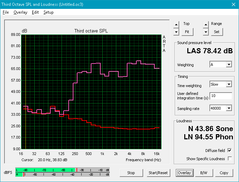
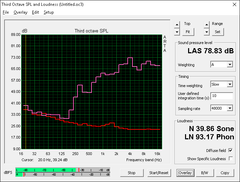
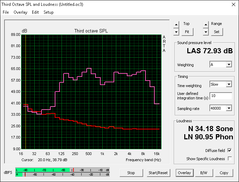
HP 250 G5 Y1V08UT audio analysis
(±) | speaker loudness is average but good (78.4 dB)
Bass 100 - 315 Hz
(-) | nearly no bass - on average 19.1% lower than median
(±) | linearity of bass is average (14.3% delta to prev. frequency)
Mids 400 - 2000 Hz
(+) | balanced mids - only 2.2% away from median
(+) | mids are linear (6.8% delta to prev. frequency)
Highs 2 - 16 kHz
(±) | higher highs - on average 5.2% higher than median
(+) | highs are linear (6.9% delta to prev. frequency)
Overall 100 - 16.000 Hz
(±) | linearity of overall sound is average (21.5% difference to median)
Compared to same class
» 53% of all tested devices in this class were better, 8% similar, 39% worse
» The best had a delta of 7%, average was 21%, worst was 53%
Compared to all devices tested
» 60% of all tested devices were better, 7% similar, 33% worse
» The best had a delta of 4%, average was 24%, worst was 134%
Apple MacBook 12 (Early 2016) 1.1 GHz audio analysis
(+) | speakers can play relatively loud (83.6 dB)
Bass 100 - 315 Hz
(±) | reduced bass - on average 11.3% lower than median
(±) | linearity of bass is average (14.2% delta to prev. frequency)
Mids 400 - 2000 Hz
(+) | balanced mids - only 2.4% away from median
(+) | mids are linear (5.5% delta to prev. frequency)
Highs 2 - 16 kHz
(+) | balanced highs - only 2% away from median
(+) | highs are linear (4.5% delta to prev. frequency)
Overall 100 - 16.000 Hz
(+) | overall sound is linear (10.2% difference to median)
Compared to same class
» 7% of all tested devices in this class were better, 2% similar, 91% worse
» The best had a delta of 5%, average was 18%, worst was 53%
Compared to all devices tested
» 4% of all tested devices were better, 1% similar, 94% worse
» The best had a delta of 4%, average was 24%, worst was 134%
Frequency Comparison (Checkbox selectable!)
Graph 1: Pink Noise 100% Vol.; Graph 2: Audio off
Energy Management
Power Consumption
The weak performance from the Celeron N3060 is made up for by its very low power consumption. Our 250 G5 Celeron SKU demands about the same power as the older 250 G4 and the more powerful 250 G5 i5-6200U SKU when idling, but draws less than half when under load. The system won't even draw more than 14 W at most when under Prime95 and FurMark stress.
The small power adapter (9 x 3.5 x 2.5 cm) is rated for up to 45 W, so there is significant headroom even for the higher-end SKU with ULV Core i5 options.
| Off / Standby | |
| Idle | |
| Load |
|
Key:
min: | |
| HP 250 G5 Y1V08UT N3060, HD Graphics 400 (Braswell), Samsung CM871 MZNLF128HCHP, TN LED, 1366x768, 15.6" | Acer Extensa 2520-59CD 6200U, HD Graphics 520, Toshiba MQ01ABF050, TN LED, 1366x768, 15.6" | Lenovo B50-10 80QR0013GE N3540, HD Graphics (Bay Trail), Seagate Momentus Thin ST500LT012-1DG142, TN LED, 1366x768, 15.6" | Asus F540SA-XX087T N3050, HD Graphics (Braswell), Seagate Momentus Thin ST500LT012-1DG142, TN LED, 1366x768, 15.6" | HP 250 G4 T6P08ES 5200U, Radeon R5 M330, HGST Travelstar 5K1000 HTS541010A9E680, TN LED, 1366x768, 15.6" | HP 250 G5 SP X0N33EA 6200U, HD Graphics 520, SanDisk Z400s SD8SNAT-256G, TN, 1920x1080, 15.6" | |
|---|---|---|---|---|---|---|
| Power Consumption | -102% | -28% | -29% | -91% | -44% | |
| Idle Minimum * (Watt) | 3.9 | 5.8 -49% | 4.8 -23% | 3.8 3% | 4 -3% | 3.6 8% |
| Idle Average * (Watt) | 6.4 | 12.6 -97% | 7.5 -17% | 6.9 -8% | 6.5 -2% | 6 6% |
| Idle Maximum * (Watt) | 6.5 | 12.8 -97% | 9.2 -42% | 7.14 -10% | 7 -8% | 6.4 2% |
| Load Average * (Watt) | 11.1 | 27.6 -149% | 16 -44% | 20 -80% | 36 -224% | 26 -134% |
| Load Maximum * (Watt) | 13.8 | 30 -117% | 15.4 -12% | 20.7 -50% | 43.6 -216% | 28.1 -104% |
* ... smaller is better
Battery Life
Runtimes are excellent from the small 41 Wh removable battery. Users can expect over six hours of real-world WLAN use or just under four hours of heavy use. The HP can run for noticeably longer than many of its affordable competitors that often carry smaller capacity batteries. Idling on the lowest power and brightness settings can net almost 12 hours of battery life, so users with more conservative power settings than what we use for our WLAN test can last for even longer.
Charging from near empty to full capacity will take roughly 1.5 hours.
| HP 250 G5 Y1V08UT N3060, HD Graphics 400 (Braswell), 41 Wh | Acer Extensa 2520-59CD 6200U, HD Graphics 520, 37 Wh | Lenovo B50-10 80QR0013GE N3540, HD Graphics (Bay Trail), 24 Wh | Asus F540SA-XX087T N3050, HD Graphics (Braswell), 33 Wh | HP 250 G4 T6P08ES 5200U, Radeon R5 M330, 41 Wh | HP 250 G5 SP X0N33EA 6200U, HD Graphics 520, 41 Wh | |
|---|---|---|---|---|---|---|
| Battery runtime | -16% | -44% | -13% | -22% | -24% | |
| Reader / Idle (h) | 11.9 | 11.1 -7% | 10.6 -11% | |||
| WiFi v1.3 (h) | 6.3 | 5.3 -16% | 3.5 -44% | 5.5 -13% | 5.7 -10% | 5.8 -8% |
| Load (h) | 3.8 | 1.9 -50% | 1.8 -53% |
Pros
Cons
Verdict
Older mainstream notebooks commonly pair able processors with slow HDDs that would often bottleneck system performance. Our configured Celeron N3060 HP SKU is the same and opposite story as it pairs a very weak processor with a fast SSD. The end result is the same: Slow performance meant only for word processing, browsing, video playback, and other low-power activities not unlike an Atom-based netbook.
Advantages include silent operation, cheap starting price, and long runtimes. The chassis itself is run-of-the-mill and we highly suggest investing in a stronger SKU with a Core ix processor and FHD screen for those considering the 250 G5. A quick calibration is also recommended to get the most out of the display and, if price is a concern, the older 250 G4 is not significantly different and will even perform faster if properly configured.
Avoid the lowest-end SKU with the Celeron N3060 and the HP 250 G5 becomes an easier recommendation for basic tasks.
HP 250 G5 Y1V08UT
- 10/30/2016 v5.1 (old)
Allen Ngo




